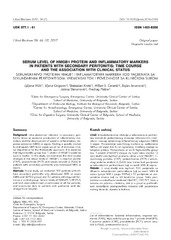Приказ основних података о документу
Serum Level of HMGB1 Protein and Inflammatory Markers in Patients with Secondary Peritonitis: Time Course and the Association with Clinical Status
| dc.creator | Milić, Ljiljana | |
| dc.creator | Grigorov, Ilijana | |
| dc.creator | Krstić, Slobodan | |
| dc.creator | Ćeranić, Miljan S. | |
| dc.creator | Jovanović, Bojan | |
| dc.creator | Stevanović, Jelena | |
| dc.creator | Peško, Predrag | |
| dc.date.accessioned | 2017-11-23T11:30:01Z | |
| dc.date.available | 2017-02-20T13:59:31Z | |
| dc.date.issued | 2017 | |
| dc.identifier.issn | 1452-8258 | |
| dc.identifier.uri | http://www.degruyter.com/view/j/jomb.2017.36.issue-1/jomb-2016-0016/jomb-2016-0016.xml | |
| dc.identifier.uri | https://radar.ibiss.bg.ac.rs/handle/123456789/2558 | |
| dc.description.abstract | Background: Intra-abdominal infection in secondary peritonitis drives as excessive production of inflammatory mediators and the development of systemic inflammatory response syndrome (SIRS) or sepsis. Finding a specific marker to distinguish SIRS from sepsis would be of immense clinical importance for the therapeutic approach. It is assumed that high-mobility group box 1 protein (HMGB1) could be such a marker. In this study, we examined the time course changes in the blood levels of HMGB1, C-reactive protein (CRP), procalcitonin (PCT) and serum amyloid A (SAA) in patients with secondary peritonitis who developed SIRS or sepsis. Methods: In our study, we evaluated 100 patients with diffuse secondary peritonitis who developed SIRS or sepsis (SIRS and SEPSIS group) and 30 patients with inguinal hernia as a control group. Serum levels of HMGB1, CRP, PCT, and SAA were determined on admission in all the patients, and monitored daily in patients with peritonitis until discharge from hospital. Results: Preoperative HMGB1, CRP, PCT and SAA levels were statistically highly significantly increased in patients with peritonitis compared to patients with inguinal hernia, and significantly higher in patients with sepsis compared to those with SIRS. All four inflammatory markers changed significantly during the follow-up. It is interesting that the patterns of change of HMGB1 and SAA over time were distinctive for SIRS and SEPSIS groups. Conclusions: HMGB1 and SAA temporal patterns might be useful in distinguishing sepsis from noninfectious SIRS in secondary peritonitis. | en |
| dc.relation | info:eu-repo/grantAgreement/MESTD/Basic Research (BR or ON)/173020/RS// | |
| dc.rights | openAccess | |
| dc.rights.uri | https://creativecommons.org/licenses/by-nc-nd/4.0/ | |
| dc.source | Journal of Medical Biochemistry | |
| dc.subject | HMGB1 | |
| dc.subject | Inflammation markers | |
| dc.subject | Secondary peritonitis | |
| dc.subject | Sepsis | |
| dc.subject | Systemic inflammatory response syndrome | |
| dc.title | Serum Level of HMGB1 Protein and Inflammatory Markers in Patients with Secondary Peritonitis: Time Course and the Association with Clinical Status | en |
| dc.type | article | |
| dc.rights.license | BY-NC-ND | |
| dcterms.abstract | Пешко, Предраг; Крстић, Слободан; Милић, Љиљана; Ћеранић, Миљан С.; Григоров, Илијана; Јовановић, Бојан; Стевановић, Јелена; | |
| dc.rights.holder | © 2017 Authors | |
| dc.citation.issue | 1 | |
| dc.citation.volume | 36 | |
| dc.description.other | Journal of Medical Biochemistry (2017), 36(1): 44-53 | |
| dc.identifier.doi | 10.1515/jomb-2016-0016 | |
| dc.identifier.scopus | 2-s2.0-85011292005 | |
| dc.identifier.wos | 000393585400007 | |
| dc.citation.apa | Milić, L., Grigorov, I., Krstić, S., Ćeranić, M. S., Jovanović, B., Stevanović, J., & Peško, P. (2017). Serum Level of HMGB1 Protein and Inflammatory Markers in Patients with Secondary Peritonitis: Time Course and the Association with Clinical Status. Journal of Medical Biochemistry, 36(1), 44–53. | |
| dc.citation.vancouver | Milić L, Grigorov I, Krstić S, Ćeranić MS, Jovanović B, Stevanović J, Peško P. Serum Level of HMGB1 Protein and Inflammatory Markers in Patients with Secondary Peritonitis: Time Course and the Association with Clinical Status. J Med Biochem. 2017;36(1):44–53. | |
| dc.citation.spage | 44 | |
| dc.citation.epage | 53 | |
| dc.type.version | publishedVersion | en |
| dc.identifier.fulltext | https://radar.ibiss.bg.ac.rs//bitstream/id/3408/JMedBiochem_2017_36_1_44-53.pdf | |
| dc.citation.rank | M23 |

